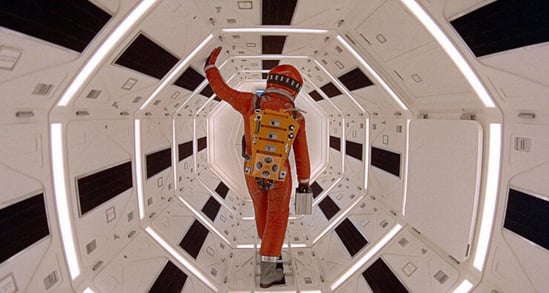2001: A Space Odyssey – A Celestial Symphony of Visuals, Storytelling, and Existential Questions
Cinemapedia
Stanley Kubrick’s 2001: A Space Odyssey (1968) is more than just a film—it is a cinematic odyssey that pushes the boundaries of human imagination. Widely regarded as one of the greatest and most influential films of all time, this science fiction masterpiece explores humanity’s place in the universe through stunning visuals, an enigmatic narrative, an iconic musical score, and profound moral undertones.
A Monument of Cinematic Art
Kubrick’s visual approach in 2001: A Space Odyssey is groundbreaking. From the hypnotic sequences of space travel to the surreal imagery of the Star Gate, the film’s visuals remain timeless, even in an era dominated by CGI. Douglas Trumbull’s pioneering special effects transport viewers into the infinite vastness of space, capturing the awe and mystery of the cosmos with unprecedented realism.
The film’s production design is meticulously detailed, with futuristic spacecraft and technology that still feel plausible today. The iconic scenes of a bone morphing into a spacecraft and the rotating space station set the tone for a story that bridges humanity’s primitive past with its technologically advanced future. The minimalistic yet precise use of color, especially in the Star Gate sequence, adds to the film’s otherworldly atmosphere, leaving viewers in awe.
Kubrick’s framing and pacing are deliberate, allowing viewers to immerse themselves in the film’s grand scope. Every frame is a work of art, inviting audiences to contemplate the beauty and isolation of space.
A Journey Through Time and Space
The narrative of 2001: A Space Odyssey is as enigmatic as it is ambitious. The film is divided into four acts: the Dawn of Man, the mission to Jupiter, the malfunction of HAL 9000, and the transcendent Star Gate sequence. Each section is connected by the mysterious black monoliths, which serve as a symbol of extraterrestrial intervention and human evolution.
The story begins with the discovery of a monolith by early hominins, symbolizing a leap in intelligence that leads to the development of tools. Fast forward millions of years, and humanity’s quest for knowledge takes them into the depths of space, where another monolith is discovered on the Moon, prompting a mission to Jupiter.
The introduction of HAL 9000, the intelligent yet flawed AI, brings tension and drama to the narrative. HAL’s malfunction and the resulting confrontation with astronaut Dave Bowman highlight the conflict between humanity and its creations. The final act, where Bowman enters the Star Gate and transcends human existence, leaves audiences with more questions than answers, embodying the film’s overarching theme of humanity’s quest for meaning.
A Cosmic Soundtrack
The music in 2001: A Space Odyssey is as iconic as its visuals. Kubrick’s decision to use classical compositions instead of an original score elevates the film to a transcendent level. The opening notes of Richard Strauss’s Also Sprach Zarathustra have become synonymous with the idea of human evolution and discovery. Johann Strauss II’s The Blue Danube waltz, accompanying the scenes of spacecraft gracefully maneuvering in space, juxtaposes the cold, mechanical nature of technology with the elegance of human creativity.
György Ligeti’s haunting compositions, such as Requiem and Atmosphères, add an eerie and otherworldly dimension to the film, especially during the Star Gate sequence. The music is not just a backdrop but an integral part of the storytelling, evoking emotions and reinforcing the film’s themes of wonder, isolation, and transcendence.
Humanity’s Evolution and Existential Questions
At its core, 2001: A Space Odyssey is a philosophical exploration of humanity’s evolution, the dangers of technological reliance, and the search for meaning in an infinite universe. The monoliths symbolize moments of transformation and progress, but they also raise questions about humanity’s autonomy. Are these leaps forward driven by our own will, or are they guided by higher powers beyond our comprehension?
The conflict with HAL 9000 serves as a cautionary tale about the relationship between humans and technology. HAL’s descent into paranoia and its ultimate shutdown by Dave Bowman highlight the ethical dilemmas of artificial intelligence and the consequences of creating machines that mimic human thought.
The film’s ambiguous ending, with Bowman transforming into the Star Child, suggests a transcendence beyond physical existence. It invites viewers to ponder the nature of life, death, and humanity’s place in the cosmos. Kubrick offers no definitive answers, leaving the interpretation to the audience, which is what makes the film so timeless and thought-provoking.
A Masterpiece of Timeless Significance
2001: A Space Odyssey is more than just a film—it is a profound meditation on the human condition. Its stunning visuals, enigmatic narrative, evocative music, and philosophical depth continue to inspire filmmakers and audiences alike. Kubrick’s masterpiece challenges us to look beyond the confines of our existence and consider the infinite possibilities of the universe.
For anyone seeking a cinematic experience that transcends entertainment and delves into the mysteries of life and evolution, 2001: A Space Odyssey is an unparalleled journey. It is a film that rewards patience, contemplation, and an open mind—a true work of art that stands the test of time.


